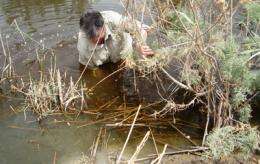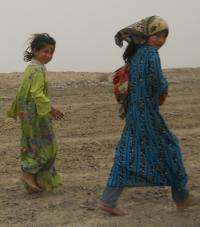Lessons from Iraq: Urban marshes and city survival

Jennifer Pournelle is continuing to build the case that natural wetlands, rather than irrigated fields, are the fertile ground from which cities initially emerged in Mesopotamia. And her conclusions about the importance of wetlands to a sustainable urban environment – or, in fact, any environment – have particular resonance in southern Iraq. That area is both the site of her studies and the region where Saddam Hussein forcibly drained marshes to drive out the local populace after the first Gulf war.
Pournelle, an archaeologist and anthropologist in USC's School of Earth, Ocean, and Environment, thinks the conventional wisdom about irrigation and city-building is backward.
"In most people's heads – archaeologists, ecologists, environmental scientists – there's the idea that cities happen because somebody invented and managed irrigation," Pournelle said. "My argument is, 'No – irrigation is what happened because you had cities, but the marshlands were moving away from them.'
"That's what marshes do. Deltas build up, river mouths migrate, and the marshes go with them. The city's stuck where it is, so it has to start irrigating to raise crop production and replace all of the marshland resources that have moved too far away."
Working with pilot funding from the National Science Foundation, Pournelle recently published in the journal Radiocarbon the first dating of field samples from southern Iraq in more than two decades. "We were allowed to go to some very major archaeological sites, among them Eridu, considered to be the oldest city in the world," she said.

Her team, which included Carrie Hritz of The Pennsylvania State University and Jennifer Smith of Washington University in St. Louis, collected fossilized shell samples at varying heights at Tell Abu Shahrain, the high mound of Eridu, a mound that rises out of the surrounding plain as the result of thousands of years of ancient human habitation. The site was occupied from at least 8000 to 4000 years Before the Common Era (BCE).
The shells were originally components of mud bricks used in local construction at the time, and the radiocarbon dating analysis was clear. "What we found was that in this area, right around where this mound is, there were marshes during the bracketed dates," Pournelle said. "And those bracketed dates are dates when the city was forming, alive, well, and active."
Pournelle says that showing wetlands were part of the active city, rather than obstacles to its creation that were removed at the onset, shows "how tenuous a lot of the accepted wisdom is. That accepted wisdom is based on literary analyses of cuneiform texts—analyses that were done in the 1920s to the 1950s, before radiocarbon dating was even invented. Those ideas were accepted into the canon by people from outside the field, who didn't realize that there wasn't a lot of science behind that – almost none."
The preliminary data were significant enough for the NSF to follow up with a three-year grant to better establish the relation between natural marshes, irrigation, and the beginning and end of city occupation.
"If I can show that this model is durably true, then we need to start paying very serious attention to any city when we start depriving it of its wetlands," said Pournelle. "Things might not be immediately apparent on the scale of 10 to 20 years, but on a scale of 50, 100, 500, or 1,000 years."
Pournelle's work shows that replacing wetlands with irrigated crops makes an area's resource base inherently more fragile over the long term. "Wetlands are more resilient than drained and plowed soils, because they have far more robust ecosystems, with not just a lot of biodiversity, but with multiple competitors in each niche," she said. "When you have a patchwork of competing species, in drier conditions, some will flourish, and others will die back. In wetter conditions, others will flourish, and different ones will die back. It becomes a resilient, self-correcting system – and people are part of that natural process. There's almost never just one big catastrophic event that can wipe out everything all at once."
"And a perfect place to study that, right now, is in southern Iraq, where the forcible draining of all of those marshes, between 1997 and 2001, accomplished in a decade changes that have happened elsewhere over centuries. Most notably, it created 500,000 refugees, who fled to refugee camps in Iran or to slums in cities like Nasiriyah, Basra, and Baghdad."
"The entire region has been affected in multiple ways. Obviously the hydrology has profoundly changed. Very little of that land is arable – it's too saline, there's no drainage, and there's no water. The ecosystem collapse is so profound that we're talking about pollution and contamination on a scale that we haven't seen in this country in decades—sufficient to cause extreme morbidity, and even mortality, especially among children and the elderly."
Pournelle hopes that insight from her research over the coming three years in Iraq will lay the groundwork for seriously confronting the environmental damage inflicted by Saddam Hussein's draconian policies in the area. "That's a really important question we want to address with this project," she said. "Can we figure out how to put this right?"
More information: sc.academia.edu/JenniferPourne … L_FROM_SOUTHERN_IRAQ
Provided by University of South Carolina
















